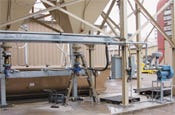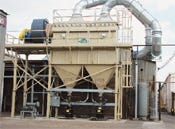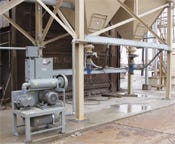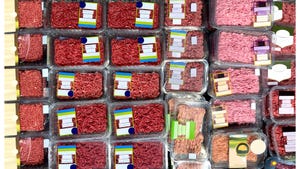Using Eductors to Convey Abrasive or Hazardous Dust to Roll-Off Containers
April 2, 2008
|
A U.S. Army facility needed to convey steel shot and garnet sand from 17 dust collector outlets and convey the dust to roll-off containers. The used sand and shot, which also contain debris from a metal blasting process, are considered a Class 9 hazardous waste and are delivered to roll-on/roll-off containers that are rated for hazardous materials. The powder and dust flow rate from each dust collector cell is 100 or 250 lb/hr, and convey distances to the roll-off containers vary from approximately 70 to 150 ft with four or six bends. Bulk densities are 100 to 120 lb/cu ft for the steel shot and 90 to 100 lb/cu ft for the garnet sand.
The compelling design goal of the engineers on this project was the elimination of fugitive dust, leakage, or blowback from the 17 feeders that are used to convey material from each dust collector outlet. Conveying had to be clean, reliable, and dust free.
When conveying material from dust collectors, many system designers may prefer vacuum or negative conveying systems, since a vacuum system creates a deeper vacuum in the collector, pulling material out without the chance of leakage. However, since the destination of the material at the U.S. Army facility was a series of ever-changing roll-off containers, mounting or connecting the necessary vacuum receiver atop each container was impractical.
|
The use of rotary valves or airlocks was unsuitable for this application for three major reasons. First, airlocks inevitably generate blowback and fugitive dust, which are unacceptable in the case of hazardous powders. Second, garnet sand and steel shot are extremely abrasive. Even with initially tight rotor and housing clearances to minimize airlock blowback, erosive wear would quickly increase these gaps, increasing blowback. That, in turn, would accelerate wear and create more dust leakage. Third, abrasive powders cause frequent bearing, seal, and airlock failures.
Consequently, positive pneumatic conveying was the preferred option for conveying material into the container, particularly since the destination containers vent back to the dust collectors. The engineering team assigned to this project—including both consulting engineers and the dust collector manufacturers—chose wear-treated Fox venturi eductors from Fox Valve Development Corp. (Dover, NJ). Because eductors create a vacuum at the point of powder ingress, there is no leakage and no blowback. Because they have no moving parts, eductors can convey dense, abrasive, and hazardous materials without the need for maintenance.
|
The installation at the Army facility, which started up in early 2007, duplicated dozens of eductor installations from the 1990s at many foundries in the upper Midwest, such as the one pictured here. These foundries are often located near homes in small towns and therefore have zero tolerance for fugitive dust leakage. These facilities also convey their dust into roll-off containers, or gondolas.
Fox Valve supplied matched blowers to drive pairs of eductors. One small blower simultaneously drives two eductors under each cell of a dust collector. The eductor design automatically balances the airflow to each unit, which remains constant whether the eductor is or is not conveying powders. As shown in the photo below, shorter convey systems can use small side-channel blowers that run at 3 psig, while longer convey lines use pd blowers supplied by Fox that run at 3 to 8 psig, depending on performance requirements. Compressed air is never used to drive venturi eductors.
The engineering contractors selected Fox eductors with a standard cleanout port, which enables quick and easy access to eductor internals without the need to disconnect the unit. This feature addressed clogging that may have been caused by unexpected foreign objects, debris, or clumps in the dust collectors.
For more information on Fox Venturi Eductors and Fox Valve Development Corp., call 973-328-1011 or visit www.foxvalve.com.
You May Also Like





